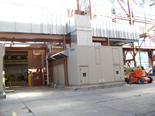
One of the two Munters heat pipe energy recovery units that was installed outside of the aircraft hangar. (Click on the image for an enlarged view.)
The aircraft hangar provides corrosion control work for large aircraft including KC-135 tankers and B-52 bombers.
The building required compliance with Executive Order 13423 that calls for all federal agencies to improve energy efficiency and reduce greenhouse gas emissions. It mandates reducing energy intensity by 3 percent annually through the end of fiscal year 2015, or 30 percent by the end of fiscal 2015 relative to the baseline of the agency’s energy use in fiscal year 2003. The order, titled, “Strengthening Federal Environmental, Energy and Transportation Management,” was issued Jan. 24, 2007 by former President George W. Bush.
A design consulting engineer from FPM Group, with offices in Midwest City, Okla., oversaw the renovation. FPM Group consulted with Bruce Albertson, sales engineer with Engineered Equipment Inc., an HVAC solutions company based in Oklahoma City, to spec the new equipment needed.
“The process of supplying and exhausting air in a large hangar requires significant amounts of energy,” said Albertson. “It was necessary to update the current HVAC equipment to meet these new energy-efficiency goals.”
Alberston recommended the installation of two Munters large heat pipe energy recovery units featuring 45,000 cfm supply air and 70,000 cfm exhaust air.
Munters manufactures engineered products designed to economically control humidity and temperature, provide energy recovery, and/or utilize direct or indirect evaporative cooling for comfort, process, and environmental protection.
The heat pipe heat exchanger is a sensible heat recovery device. It provides sensible heat transfer between two airstreams using a counterflow configuration to maximize heat transfer and minimize pressure drop. The device contains rows of finned tubes partially filled with refrigerant and permanently sealed.
Heating one side of a heat pipe establishes a continuous process within it whereby the warmer side acts as an evaporator and the colder side a condenser. A sealed center partition prevents cross contamination of the two airstreams. The result is a sensible heat transfer from the hot to the cold airstream.
“Use of a heat pipe energy exchanger allows for ventilation codes to be met, reduces heating and cooling requirements, and solves existing indoor air quality problems,” said Albertson.
One project challenge to overcome was the need to fit the units in a tight space between existing building columns.
“We had tight building constraints due to column locations in the front and back of the current units that supported ductwork to and from the hangar,” said Albertson. “It was difficult to design these two large systems that contain both makeup and exhaust air to fit into those spaces.”
The end result was two, custom-designed 12-foot-tall, 12-foot-wide, 25-foot-long units that included four-inch double-wall construction, vertical heat pipes, no exhaust fans, and a custom airflow configuration with single pass through the space.
Installed and now operational, the new equipment has created the energy savings required. Initial estimates show that two units at 45,000 cfm each can save $24,500 total with heat recovery from 57°F and below. These calculations are based on 60° space temperature and Oklahoma City weather bin data, $15.00 per 1 million Btuh steam costs.
“We take exhaust air and run it through the other side of the heat exchanger and recover about 60 percent of the energy,” said Albertson. “For example, the hangar is maintained at 60° in the winter. If we take 10° air from the outside through the heat exchanger and warm it up to about 40° before we use the heating coil, then we are saving energy. The exhaust air decreases from 60° to about 30°.
“The client is extremely happy with the support we received from beginning to end and the results we achieved,” added Albertson.
Publication date:06/20/2011

Report Abusive Comment